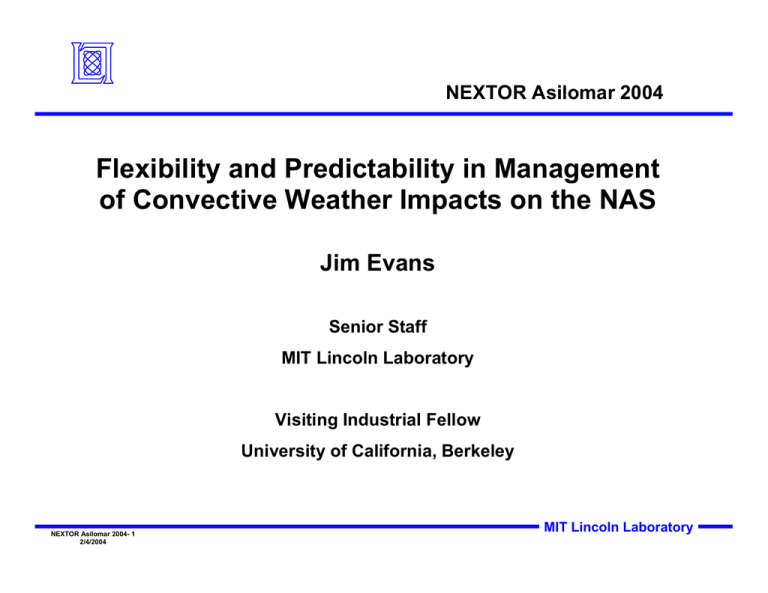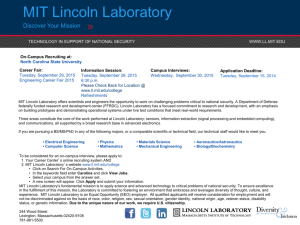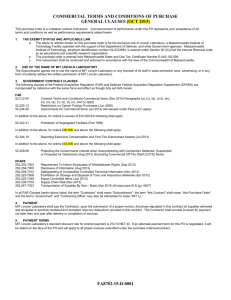Flexibility and Predictability in Management Jim Evans NEXTOR Asilomar 2004
advertisement

NEXTOR Asilomar 2004 Flexibility and Predictability in Management of Convective Weather Impacts on the NAS Jim Evans Senior Staff MIT Lincoln Laboratory Visiting Industrial Fellow University of California, Berkeley NEXTOR Asilomar 2004- 1 2/4/2004 MIT Lincoln Laboratory Outline • Why do we care? – Delays – Metrics implications • Overall FAA/airline weather impact mitigation process – Ability to predict weather impact with sufficient lead time is poor • Insights from the CIWS benefits assessment • How can we achieve a higher degree of predictability through increasing flexibility in ATM during adverse weather • Metrics and system design implications NEXTOR Asilomar 2004- 2 2/4/2004 MIT Lincoln Laboratory Why of Interest and Concern • Airlines seek to reliably and economically deliver the desired product – Predictability is essential to airline network design and operation – Want flexibility to make adjustments to address problems and handle flight specific issues (e.g., high value connections) – Use of off ATC-preferred routes as a key flexibility index • Initiatives underway to improve information transfer and navigation capability seek to provide a more predictable system for scheduling and increase flexibility – But predictability and flexibility are very hard to achieve when major capacity losses occur “randomly” • Need to improve system design and develop better metrics capabilities NEXTOR Asilomar 2004- 3 2/4/2004 MIT Lincoln Laboratory Trends in Aviation Delays 60 50 Thousands of Delays 2002 2001 40 2000 1999 30 1998 1997 20 1996 2003 10 0 Jan Feb Mar Apr May Jun Jul Aug Sep Oct Nov Dec • Peak delays – summer thunderstorms NEXTOR Asilomar 2004- 4 2/4/2004 Delay reduction as metric MIT Lincoln Laboratory Air Traffic Congestion Air Traffic 09/12/02 1000 UTC – 09/13/02 1000 UTC CIWS Domain ATC chokepoints [ from FAA 2002 Airport Capacity Enhancement (ACE) Plan ] # of aircraft Increased use of point-to-point flights (versus hubs) and use of alternative airports increases en route congestion and hence, difficulty in providing flexibility and predictability when adverse weather occurs NEXTOR Asilomar 2004- 5 2/4/2004 MIT Lincoln Laboratory Frequency of Convective Storm Impacts Unorganized Convective Events Total Storm Events per ARTCC May-Aug 2002 110 64 84 29 119 55 93 11 Unorganized Convective Events 2003 ZBW ZAU 128 54 139 42 80 31 98 19 ZNY ZOB Organized Convective Events ZID 2002 ZDC 146 52 151 59 2003 91 25 “Unorganized” NEXTOR Asilomar 2004- 6 2/4/2004 Organized Convective Events 167 41 “Organized” MIT Lincoln Laboratory Outline • Why do we care? – Delays • Overall FAA/airline weather impact mitigation process – Ability to predict weather impact with sufficient lead time is poor • Insights from the CIWS benefits assessment • How can we achieve a higher degree of predictability through increasing flexibility in ATM during adverse weather • Metrics and system design implications NEXTOR Asilomar 2004- 7 2/4/2004 MIT Lincoln Laboratory Weather Impact Mitigation Paradigm Nowcast Products Weather Sensing Systems • Weather Radar • Satellite • Obs • Location • Intensity • Height • Movement User Interface Determine weather impact Weather displays Forecast Products NWS Models Operational Decision Loop ATC displays TFM displays Determine ATC impact Develop mitigation plans Decide on mitigation plan Forecasters Data Driven Algorithms Execute mitigation plan Traffic Flow Decision Support Tools ETMS CRCT URET RAPT FACET-AOC CTAS URET SWEPT “Success” in FAA/airline context = executed an appropriate weather impact mitigation plan Must execute the decision loop on a time scale compatible with lead time for accurate forecasts NEXTOR Asilomar 2004- 8 2/4/2004 MIT Lincoln Laboratory FAA/Airline “Spring 2K” Planning Collaborative Convective Forecast Product (CCFP) Strategic Planning CCFP “Play book” Play book has routes to get around “impenetrable” wx 2, 4 and 6 hour predictions generated by FAA/NWS/airline meteorologist collaboration every 2-4 hours Each region of predicted convective activity has estimates of: Thunderstorm coverage – three* intervals (e.g., 25-49%) Confidence in forecast= low, medium, high * To become two intervals NEXTOR Asilomar 2004- 9 2/4/2004 FAA/Airline Strategic Planning Team Strategic Plan Teleconference Every 2 hours Delays that occur reflect forecasts plus plans plus actual wx MIT Lincoln Laboratory CCFP Coverage vs Actual Coverage (statistics for 2003 are similar) Approx. 70% of convection that occurred was outside forecast regions 95% of forecasts issued NEXTOR Asilomar 2004- 10 2/4/2004 Forecast Coverage MIT Lincoln Laboratory Outline • Why do we care? – Delays • Overall FAA/airline weather impact mitigation process – Ability to predict weather impact with sufficient lead time is poor • Insights from the CIWS benefits assessment • How can we achieve a higher degree of predictability through increasing flexibility in ATM during adverse weather • Metrics and system design implications NEXTOR Asilomar 2004- 11 2/4/2004 MIT Lincoln Laboratory Corridor Integrated Weather System (CIWS) Products 0 to 2-hr forecast ASR9 NEXRAD NEXRAD lightning Scores NEXRAD VIL mosaic Satellite background Cell motion/SEP Echo tops labels High res echo tops NEXTOR Asilomar 2004- 12 2/4/2004 MIT Lincoln Laboratory CIWS Benefits Assessment Detailed Case Study Analyses Observations During “Blitz events” Cases identified in daily feedback 6 Multi-day “blitz” observations of product usage # of improved ATC decisions Average benefit ‘Annualized’ CIWS Delay Benefits Individual Delay Savings Events (for each ATC decision) Frequency of convective weather at various ATC facilities NEXTOR Asilomar 2004- 13 2/4/2004 MIT Lincoln Laboratory CIWS 2003 Operational Benefits Route Impacts / Traffic Flow Management CIWS Benefit Times/year Benefits from Randomly Chosen Instances of Routes Kept Open Facility Dates Direct Delay (Hrs) ZAU 4/30 6/26 14 1 106 •Jet routes kept open or reopened earlier 699 ZID 6/10 7/10 7/23 • Proactive, efficient reroutes 501 ZOB 5/8 7/6 8/3 4 18 189 • Directing pathfinders 300 ZDC 7/22 7/23 9/3 8 3 29 • Identifying opportunities to fly over storms 109 ZBW Delay savings > $ 110 M per year Other uses being quantified: Better use of delay programs More departures during severe wx Reduced MIT restrictions NEXTOR Asilomar 2004- 14 2/4/2004 ZNY 6/11 6/12 70 5 8/5 3 7 8/5 2 49 Annual benefit using above instances to estimate mean benefits: 42,457 hours ~ $ 178 M (including passenger time) MIT Lincoln Laboratory Examples of Different Cases A 8/3/03 J80 J80 1900 UTC B J80 J80 J80 1900 UTC 5/8/03 Low benefit – J80 blocked in IL NEXTOR Asilomar 2004- 15 2/4/2004 High benefit: few other usable E-W routes MIT Lincoln Laboratory Understandings from CIWS Study • Delays and benefits varied greatly for nominally similar “local” convective situations due to queues and overall network context – Queue delay is very sensitive to demand, fair and bad weather capacity, and time duration of bad weather – Need a very detailed knowledge of weather locations and 3D structure to accurately assess impact of weather • System design implications – Predictions of ATC impact of storms hours in advance are likely to have a very wide range of possibilities for ATC impact – Need to focus on options for maximizing flexibility to respond to rapidly changing situations • Metrics implication: will be very hard to normalize for weather effects of different weather (and forecasts) in delay comparison NEXTOR Asilomar 2004- 16 2/4/2004 MIT Lincoln Laboratory Outline • Why do we care? – Delays • Overall FAA/airline weather impact mitigation process – Ability to predict weather impact with sufficient lead time is poor • Insights from the CIWS benefits assessment • How can we achieve a higher degree of predictability through increasing flexibility in ATM during adverse weather • Metrics and system design implications NEXTOR Asilomar 2004- 17 2/4/2004 MIT Lincoln Laboratory Flexibility in Transcon Routing Bingo Point! NEXTOR Asilomar 2004- 18 2/4/2004 Proposal By UA at Dec 03 CDM mtg MIT Lincoln Laboratory Multi-facility Coordination for Departures Boston Center NY Center Cleveland Center NY Washington Center NEXTOR Asilomar 2004- 19 2/4/2004 MIT Lincoln Laboratory Route Availability Planning Tool (RAPT) Takes advantage of short lived opportunities for departures To be added: •Aircraft specific 3D guidance •Better support for assessing alternative routes if filed route is blocked •Pilot/dispatch CDM NEXTOR Asilomar 2004- 20 2/4/2004 MIT Lincoln Laboratory Summary • Convective weather impacts on congested airspace will continue to be a major problem for the NAS – Capacity impacts cannot be accurately predicted with the desired lead time – Classic “free flight” flexibility and predictability objectives will be hard to achieve • Will need to consider developing a flexible, agile system that facilitates coping with rapidly changing problems • Metrics implications – Reassessing system operations effectiveness metrics in context of flexible response to changing conditions – Normalization for weather and forecast differences between different time periods will require very detailed analysis + new tools NEXTOR Asilomar 2004- 21 2/4/2004 MIT Lincoln Laboratory

